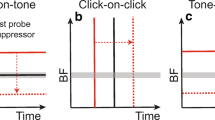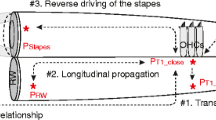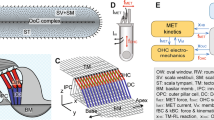Abstract
WHEN humans listen to pairs of thnes they hear additional tones, or distortion products, that are not present in the stimulus1. Two-tone distortion products are also known as combination tones, because their pitches match combinations of the primary frequencies (f1 and f2, f2>f1), such as f2–fl, (n+1)f1 – nf2 and (n +1)f2-nf1 (n = 1, 2,3 ...) (refs 2–4). Physiological correlates of the perceived distortion products exist in responses of auditory-nerve fibres5–8 and inner hair cells9 and in otoacoustic emissions (sounds generated by the cochlea, recordable at the ear canal)7,10–12. Because the middle ear responds linearly to sound13,14 and neural responses to distortion products can be abolished by damage to hair cells at cochlear sites preferentially tuned to the frequencies of the primary tones8, it was hypothesized that distortion products are generated at these sites and propagate mechanically along the basilar membrane to the location tuned to the distortion-product frequency7,8. But until now, efforts to confirm this hypothesis have failed15,16. Here we report the use of a new laser-velocimetry technique17 to demonstrate two-tone distortion in basilar-membrane motion at low and moderate stimulus intensities.
Similar content being viewed by others
References
Jones, A. T. Amer. Phys. Teacher 3, 49–51 (1935).
Goldstein, J. L. J. acoust. Soc. Am. 41, 676–689 (1967).
Smoorenburg, G. F. J. acoust. Soc. Am. 52, 615–632 (1972).
Zurek, P. M. & Sachs, R. M. Science 205, 600–602 (1979).
Buunen, T. J. F. & Rhode, W. S. J. acoust Soc. Am. 64, 772–781 (1978).
Goldstein, J. L. & Kiang, N. Y. S. Proc. IEEE 56, 981–992 (1968).
Kim, D. O., Molnar, C. E. & Matthews, J. W. J. Acoust. Soc. Am. 67, 1704–1721 (1980).
Siegel, J. H., Kim, D. O. & Molnar, C. E. J. Neurophysiol. 47, 303–328 (1982).
Nuttall, A. L. & Dolan, D. F. J. acoust. Soc. Am. 87, 782–790 (1990).
Kemp, D. T. Arch. Otorhinolaryngol. 224, 37–45 (1979).
Mountain, D. C. Science 210, 71–72 (1980).
Siegel, J. H. & Kim, D. O. Hear. Res. 6, 171–182 (1982).
Buunen, T. J. F. & Vlaming, M. S. M. G. J. acoust. Soc. Am. 69, 744–750 (1981).
Guinan, J. J. Jr & Peake, W. T. J. acoust. Soc. Am. 41, 1237–1261 (1967).
Rhode, W. S. in Psychophysics and Physiology of Hearing (eds Evans, E. F. & Wilson, J. P.) 27–38 (Academic, London, 1977).
Wilson, J. P. & Johnstone, J. R. Nature 241, 206–207 (1973).
Ruggero, M. A. & Rich, N. C. Hear. Res. (in the press).
Patuzzi, R., Sellick, P. M. & Johnstone, B. M. Hear. Res. 13, 19–27 (1984).
Robles, L., Ruggero, M. A. & Rich, N. C. J. acoust. Soc. Am. 80, 1364–1374 (1986).
Robles, L., Ruggero, M. A. & Rich, N. C. in Cochlear Mechanisms, Structure, Function and Models (eds Wilson, J. P. & Kemp, D. T.) 369–375 (Plenum, New York, 1989).
Robles, L., Ruggero, M. A. & Rich, N. C. in Mechanics and Biophysics of Hearing (eds Dallos, P., Geisler, C. D., Matthews, J. W., Ruggero, M. A. & Steele, C.) (Springer-Verlag, in the press).
Nuttall, A. L., Dolan, D. F. & Avinash, G. in Mechanics and Biophysics of Hearing (eds Dallos, P., Geisler, C. D., Matthews, J. W., Ruggero, M. A. & Steele, C.) (Springer-Verlag, in the press).
Ruggero, M. A. & Rich, N. C. J. Neurosci. (in the press).
Sellick, P. M., Patuzzi, R. & Johnstone, B. M. J. acoust. Soc. Am. 72, 131–141 (1982).
Author information
Authors and Affiliations
Rights and permissions
About this article
Cite this article
Robles, L., Ruggero, M. & Rich, N. Two-tone distortion in the basilar membrane of the cochlea. Nature 349, 413–414 (1991). https://doi.org/10.1038/349413a0
Received:
Accepted:
Issue Date:
DOI: https://doi.org/10.1038/349413a0
- Springer Nature Limited
This article is cited by
-
A convolutional neural-network model of human cochlear mechanics and filter tuning for real-time applications
Nature Machine Intelligence (2021)
-
Two-tone distortion in reticular lamina vibration of the living cochlea
Communications Biology (2020)
-
Integrating the active process of hair cells with cochlear function
Nature Reviews Neuroscience (2014)
-
A cochlear-bone wave can yield a hearing sensation as well as otoacoustic emission
Nature Communications (2014)
-
Schall- und Geschwindigkeits-DPOAE
HNO (2010)





